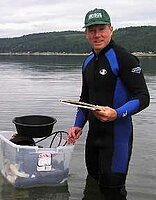3rd Distinguished Water Seminar
Dr. Donald Rosenberry - The importance of groundwater to lakes, wetlands, and streams: New methods, new understanding, and the societal relevance of research at the sediment-water interface

The annual 3rd Distinguished Water Seminar sponsored by the Institute was held on October 23, 2012. The featured speaker was Dr. Donald Rosenberry, U.S. Geological Survey National Research Program in Denver, Colorado
Don is a research hydrologist with the USGS National Research Program in Denver, Colorado, specializing in processes that affect exchange between groundwater and surface water, and in developing new tools for quantifying fluxes at the sedimentwater interface. Don received his training in geography, geology, hydrogeology, and fluvial geomorphology at Bemidji State University, University of Minnesota, and University of Colorado. Concepts and methods related to exchange between groundwater and surface water are tested at three long-term research sites where things are relatively well known. Two of these sites are nearby; one is the Cottonwood Lake area northwest of Jamestown, North Dakota, and the other is the Shingobee Headwaters Aquatic Ecosystem Study near Walker, Minnesota. New ideas and understanding usually come from taking the show on the road, however, where results seldom turn out as expected.
Abstract:
The concept that groundwater and surface water are actually one resource, linked at the sediment-water interface of lakes, wetlands, and streams, is now widely accepted by water-resource scientists and managers alike. Recent improvements in tools and measurement resolution have led to better understanding of the physical, geochemical, and biological processes that occur at this important ecotone, but this research is not just the esoteric pursuit of scientists. These processes and linkages are directly relevant to the public, particularly when they affect property values or endangered species. Examples from out-of-control wetlands and lakes in North Dakota and Minnesota, to highly controlled lakes and rivers in Washington, California, Pennsylvania, and New Hampshire, will illustrate the dynamic nature of this interface and how the public is affected, sometimes greatly, by the linkage between groundwater and surface water.


